|
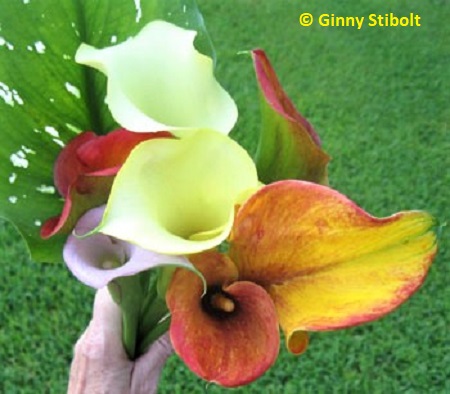
The calla lilies are blooming again
by Ginny Stibolt
As I've roamed around Florida this past year giving talks
and participating in garden fests to promote my book, Sustainable
Gardening for Florida, I have related the story of my complete failure
at growing tulips here in northeastern Florida.
Long-time Florida gardeners laugh knowingly at my tulip
blunder—many of them have been through the same process of working out
what works here in Florida and what does not. You can't necessarily
trust big box stores or nurseries to offer you plants that will actually
work here. I bought those original tulips at a big box store and followed
the instructions on the packaging for Florida, but of the 48 bulbs I
planted, only one leaf sprouted.
Don't cry for me, though. I have learned to love the place
where I am and have found some wonderful bulbs that I can plant here
that would have been difficult, if not impossible back in Maryland or
New England.
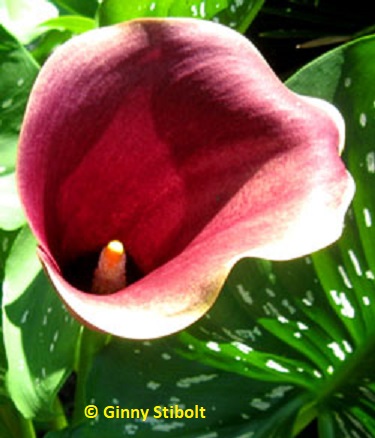 Calla
lilies Calla
lilies
Ever since I first heard Katherine Hepburn say, "The
calla lilies are in bloom again..." in the movie "Stage
Door," I've wanted to have some in my garden. Here in north
Florida, our climate is perfect for these beauties. Even their spotted,
arrow-shaped leaves are attractive.
Calla lilies are not true lilies, which have six tepals.
(Tepals are petals and sepals which are the same size and color.) As
we discussed in A plant by any common name,
they are part of the Araceae plant family also known as Arums. The flowers
are grouped in an inflorescence mounted on a thick stalk, which is underlain
or surrounded by a spathe. The spathe, a modified leaf, can be relatively
flat as in the peace lily (Spathiphyllum spp) or it can wrap
around the inflorescence like the calla lily (Zantedeschia aethiopica).
The spathe can also be shaped like a hood as in a jack-in-the-pulpit
(Arisaema spp). The whole flowering structure is called
a spadix. Note the double spathe in the orange and yellow calla in my
bouquet.
Most members of the Araceae family contain oxalate crystals, which
are irritants and may be toxic. Ironically the tubers and roots of some
members of this family such as wild taro (Colocasia esculenta)
have been extensively used as a basic food. It must be dried and
cooked to break up the crystals. Taro was imported from India to feed
the slaves and now it's one of Florida's most invasive weeds.
Other members of this widespread and well-known family include: peace
lilies ( Spathiphyllum sp.), athuriums (Anthurium andreanum),
skunk cabbage (Symplocarpus foetidus), dieffenbachia (Dieffenbachia
picta), philodendrons (Philodendron spp), split-leafed philodendron
(Monstera deliciosa), Chinese evergreens (Aglaonema spp),and
caladiums (Caladium bicolor).
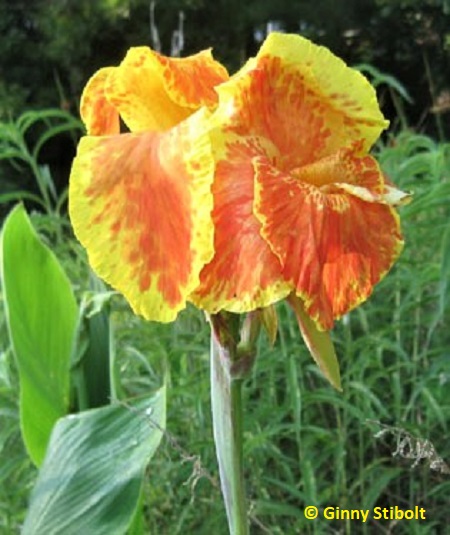 Canna
lilies Canna
lilies
These bright orange and yellow cannas (Canna x generalis) came
with the house. I bought some of the yellow, native canna lilies (C.
flaccida) at one of the Florida Native Plant Society chapter meetings
where I spoke. But until the native blooms, I have plenty of these gaudy
cultivars to enjoy. To me the flowers look like large irises gone flamboyant.
Again this is not a true lily. Canna is the only genus in its family,
Cannaceae.
They are good multipliers here, but grow best in moist habitats. I
would have had to dig these out every winter up in Maryland and I'm
not a patient enough gardener to have plants that need to be fussed
over. Here, I just cut them down in the fall if I think of it. They
and make quite a statement in the gardens.
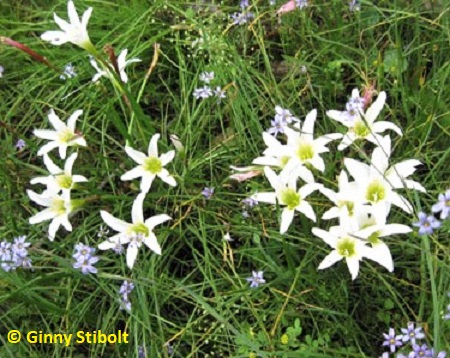 Rain lilies Rain lilies
I've written about rain lilies before in my rain
garden article, but I'm including them here, because I do enjoy them so.
This photo is of the native rain lily (Zephyranthes
atamasca), but I have also bought some yellow rain lilies
(Z. citrina), which are native to Mexico and some pink one
(Z. grandiflora),
which are native to Central America.
I love having rain lilies in my yard, because you never
know exactly when you'll see them—they tend to sprout only after a good
rain. Maybe this is why they are called fairy lilies or zephyr lilies.
The rain lilies belong to the amaryllis family Amaryllidaceae and are
closer to a true lily than the cannas or callas because they have the
classic lily flower consisting of six tepals.
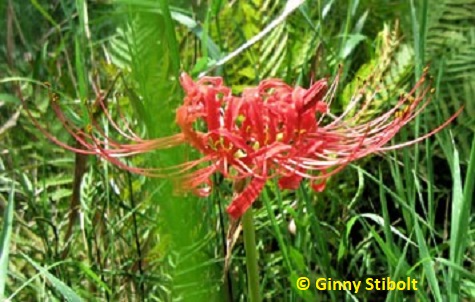 Hurricane
lilies Hurricane
lilies
Another gorgeous member of the amaryllis family, the hurricane
lily (Lycoris radiata) shows up in the fall garden long after
its leaves have died back. The flowers are borne on two-foot tall
naked stems and after it blooms, the leaves sprout and last through
the winter and into the spring. That makes it easier to plant new spring
bulbs around these lilies since the leaves still show.
Don't you just love their extra long, curving anthers?
Sometimes it's called a spider lily because those anthers evoke spider
legs. These scarlet beauties sure do add spark to the tired fall landscape
when many other flowers have passed their peak.
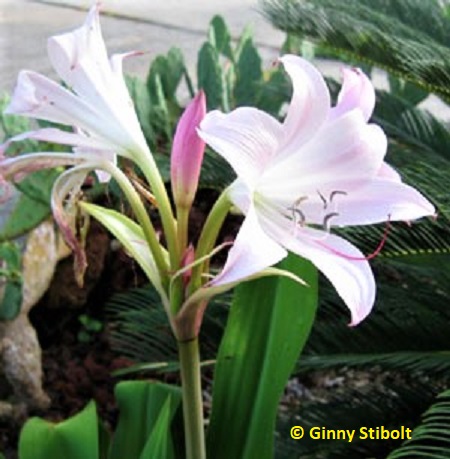 String
lilies String
lilies
I have at least two types of these lilies and maybe a third, but it
hasn't bloomed yet, so I don't know. The string lilies, often referred
to as crinum lilies, are also members of the amaryllis family. The one
in the photo is one of the hybrids (Crinum X powellii).
I also have a native to South Africa that has bright red streaks down
the center of each tepal (C. bulispermum). It's one of
the two crinums used to to create the original Powell hybrid.
I'm hoping the one that has not bloomed as yet is the native (C.
americanum), which is has white flowers with narrow tepals. It's
also known as seven sisters lily or the swamp string lily.
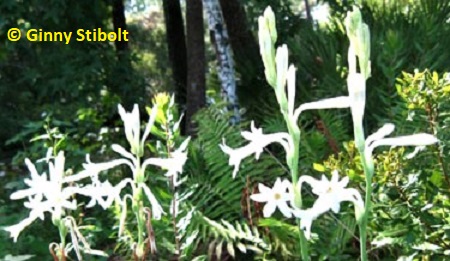 Tuberose
Tuberose
I love these bulbs—the fragrant Mexican single tuberose (Polianthes
tuberosa). Members of the agave family, Agavaceae, they grow
to almost three feet tall. They flower at night and that's when
they are the most fragrant and their waxy white flowers seem to glow
in the dusky light. The flowers stay open until morning, but then close
up during the heat of the day.
They have been
widely used in the perfume trade. An article in this week's NY
Times, Making
Flowers into Perfume, relates how you can do it yourself. Not
my cup of tea, but nice to know.
I don't cry over my failed tulips
I walk quickly by the tulip bulb displays in the stores and nurseries
in the fall these days. I know better now and isn't that what
gardening is about, learning and experimenting until you find what works
best in your own yard? I have so many wonderful bulbs here to enjoy.
After all, we live in the land of the flowers. Juan Ponce de Leon recognized
that when he landed here in northeastern Florida in April 1513.
He called this area "la Florida" in honor of Spain's Easter
celebration "Pascua florida" (feast of the flowers). Indeed!
(Update: I've moved away from planting more non-native
bulbs, so the callas and the tuberose lilies are gone, but I still have
cannas and those pink crinums, plus I've added some of the native string
lilies. I have been actively digging out the hurricane lilies that have
multiplied too rapidly in my natural spaces.)
| 


 Calla
lilies
Calla
lilies Canna
lilies
Canna
lilies Rain lilies
Rain lilies Hurricane
lilies
Hurricane
lilies String
lilies
String
lilies Tuberose
Tuberose